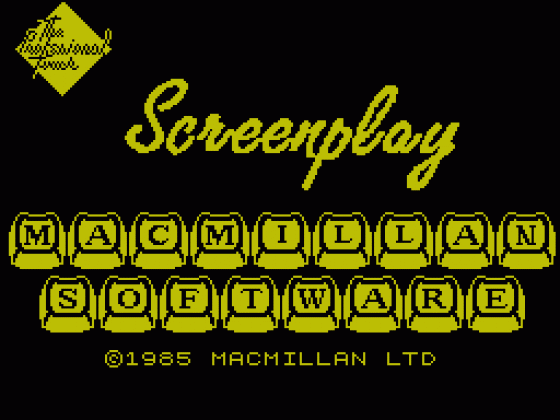Screenplay
I've been handed this piece of software to review because I'm supposed to be an expert, having spent much of my pre-CRASH time as a film cameraman and TV film editor. Whether this really qualifies me is another matter...! Screenplay is described as a means of creating your own film or TV programme on a computer. The package comes as a cassette with two programs on it and a booklet which describes some film techniques and has a section telling you how to use the software. Oddly, it doesn't really explain what the end result is going to be, although it does tell you that you can save your programmes on video if you have a video recorder.
The 26-page booklet is the obvious, indeed only, starting place. The first 16 pages are broken up into general chapters on the subject. How film works describes very briefly the technical history of film, showing 'flicker toys' and 'flicker books. It attempts to show how moving images are created by revealing lots of still shots, each action slightly advanced on the last. How the camera works explains the basic mechanism of a film camera, what photographic film is, camera shutters, lenses and film paths. Film tricks explains such devices as fades, dissolves, front projection, mattes, double exposures and the like. This is followed by How TV works, a quick run through of the electronic process and camera, which runs neatly into TV tricks, where mixes, double shots, digital machine effects, character generators and Chroma key are explained.
Making a film or TV programme outlines the roles of the producer, script, wardrobe and so on, and simply explains the function of animation, sound tracks and editing. This is followed by a section on cell animation, and then we're into using the software. So far so good. The booklet is not a handbook on film making, and its explanations are of the simplest kind, accompanied by useful illustrations. I suppose all of this could awaken someone's interest sufficiently to go into the subject in more detail but of itself it barely scratches the surface. Using the software however, is less successful in its presentation but first let's look at the computer program.

Screenplay is icon-driven. A main menu presents seven icons, load, save, wordshot, soundtrack, action, screenshot and Take 1. Load and save speak for themselves a vital function since everything you do must be saved for combining with other elements. All the other options present sub-menu icons. Word-shot is the storyboard and dialogue department. Text can be written in normal or italic mode, in several directions across the screen and in a range of ink and paper colours. Double sized letters may be used. One icon allows rubbing out of a screen, and other work may be loaded in or saved out.
Soundtrack is a music editor. Films rely heavily on sound effects (FX), but there's no provision for that, and the Spectrum isn't exactly the best beast for effects. Notes may be entered, heard or rubbed out as well as saved. Other music pieces may be loaded in for adding to them or altering.
Action is a character generator and editor, which allows you to build up figures or objects, invert them, mirror or rotate them and two-frame animate them. Icons are used for all the actions, with a grid being drawn in the display area and the cursor keys used to fill in the character grid. Black or white (rubs out pixels) is toggled on or off with the zero key. Again, ink and paper colours may be selected, and everything saved or earlier work loaded in.
Screenshot is another graphics generator/editor, allowing the creation of background scenery for your movie. A 'thick' or 'thin' pencil may be used, designs and shapes being done on a blow-up grid similar to that used in action. Closed shapes can be filled from the Spectrum's colour palette, differentiating between ink and paper.
Take 1 is the editing department, the moment when all your elements are combined to your own choosing. 'Frames' may be dealt with one by one. Characters may be brought from memory onto the screen and positioned with the cursor, then taken through the screen to complete their action. It's possible to have up to 12 sprites on screen at one time. Music may be added at appropriate moments, and the dialogue you have written can be scrolled across the bottom of the screen to complete the effect. A final icon allows a 'premiere' of your masterpiece.
The booklet details how to set up computer and video recorder to save out the finished film for a later viewing on the telly (this is where you amaze your family and friends)! Side two of the cassette has a program to load in with several elements already in there. This can be used as your first exercise in using Screenplay. The software is described as 'easy to use', but in truth I found it rather complex and fiddly and not particularly obvious in its use. The icons help, but the inter-relation of the elements is far from clear, and the booklet's descriptions of how to use the various editors or cursor functions within a mode lacks clarity, despite the icons being shown with brief explanations of their functions.
Clearly it's possible to create a semblance of a film, but the final result is somewhat primitive, looking more like an early French talkie with English subtitles. Whilst I think there maybe quite a bit of appeal for the budding film director in Screenplay, and the price of the package isn't extraordinarily high, I can't really see that there is all that much point to it, and in truth the creation of film or TV programme using this computer software seems to me to be stretching the point further than it wants to go.
Roger Kean


 1st January 1986
1st January 1986










